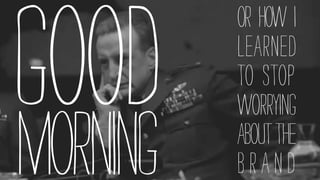
How I learned to stop worrying about the brand
- 1. MORNING GOOD OR HOW I LEARNED TO stop worrying aboutTHE B R A N D
- 3. iapologize
- 5. “We are powerfully imprisoned by the terms in which we have been conducted to think.” Buckminster Fuller
- 11. Source: Copernicus Consulting, Havas Media, CMO Council, McKinsey PEOPLE VALUE BRANDS LESS Brands in 4 out of 5 categories seen as increasingly homogeneous (and less than 1 in 10 ads seen as different) Most people “couldn’t care less if 80% of brands out there disappeared tomorrow” 5% of Americans think brands “make a noticeable, positive contribution ot their lives” CLIENTS ARE QUESTIONING THE COMMERCIAL VALUE OF BRANDS 1 out of 4 CEOs and CFOs don’t believe brand building significantly boosts corporate profitability $1 spent on brand building for every $3 spent on price cutting in CPG Brands are less valuable
- 13. The best experiences are more than twice as valuable 2.4x revenue 5 more years
- 14. “The product is the service is the marketing” Russell Davies
- 15. Stop manipulating minds. Start shaping experiences.
- 16. Respect attention, manage reputation
- 17. “You can’t build a reputation on what you’re going to do.” Henry Ford
- 18. Source: The Director Centre 2014 Mind The Gap 80% Companies that believe they provide an above average customer experience 11% Companies whose customers agree 69% service delivery gap
- 19. 4 thoughts on closing the gap
- 20. 1. Be human friendly (not human like)
- 21. Brands are not like people
- 24. Human-friendly rather than human-like
- 36. Opinions are valuable things
- 37. Risky compared to what?
- 39. Be curious
- 40. “Always be a first-rate version of yourself, instead of a second-rate version of somebody else” Judy Garland
- 41. 4. Problem finding beats problem solving
- 42. Find better problems to solve
- 43. Better problems, better questions
- 45. 1. Find a problem to solve Find a partner and ask them to tell you three things they find annoying on a daily basis something annoying, or something that you want to improve something annoying, or something that you want to improve something annoying, or something that you want to improve Pick your favourite, then switch roles ~5 min
- 46. 2. Dig a little deeper Ask your partner to describe their most recent encounter with the annoyance. Take notes: Stuck? Try asking “how?” or “why?”, then switch roles ~5 min
- 47. 3. Define the problem Now distill what you’ve learnt from your partner by completing the following sentence: your partner’s name whatever it is to be fixed or made better validate this with your partner wants so that ~5 min the desired outcome (what improvement or change does it bring about?)
- 48. 4. Sketch a solution Draw an ambitious solution to your partner’s problem, then give it a name ~5 min
- 49. 5. Present back & choose Present Take the problems and solutions you’ve defined, sketched and named and present these back to your group (1 minute each). Vote As a group, vote for the individual problem/solution you now want to take forward to solve as a group. We’re looking for one to develop further as a group within a sketch brainstorm ~10 min
- 50. 6. Sketch brainstorm Sit in silence and sketch as many propositions that might solve the problem. When you have sketched something, hold it up and explain it to the group before placing it in the middle and sketching another one. Sketch the way these propositions might work as: • A web application on a desktop, in a browser • Mobile/portable products or services on a phone or tablet • Something else - don’t feel limited by ‘devices’ or ‘platforms’. Perhaps your idea exists across the digital and physical world (e.g. as a book as well as a digital service; as an installation, wall or screen) use a computer, or start writing stuff in Word or Excel, or write a list sketch with a marker; make it visual without designing; annotate as much as you want. ~15 min DON’T DO
- 53. Thankyou
